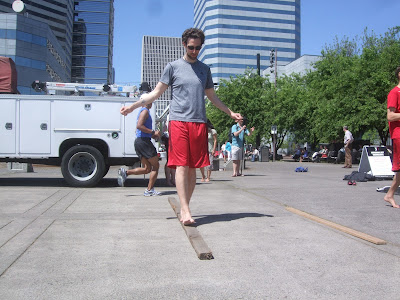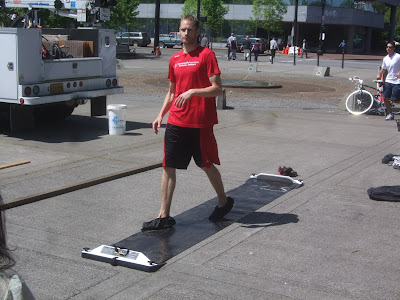Last week, we focused on gently landing and lifting, or "leafing," our feet off the ground. I'm happy to say that technique is becoming more habitual for me, and when I went on a run today with a friend I was surprised to hear how much quieter my footsteps were than his. I didn't see any need to brag about it, though.
So how do you run/walk? First you learn to walk.
We had our walking lesson, and right off the top Doc Sanatan answered a question that has nagged me every since I discovered barefoot running: how should I walk barefoot?
Don't get me wrong, I've been walking as long as I can remember and I think I'm pretty experienced at it. But once I learned that a hard heel strike could cause problems in running, I assumed the same would be true in walking. Makes sense, right? The thing is, while it's easy and natural to land on your forefoot while running, I have yet to meet anyone who can walk at a slow pace with a forefoot strike who doesn't look ridiculous. It feels weird, too.
According to Sanatan, that forefoot strike is very practical when you're running because you're coming down from a liftoff with all your weight landing on your foot as it touches the ground. In walking, however, we aren't falling out of the sky and have the opportunity to place our heel on the ground gently, then lower the balls and toes of our foot and then transfer the weight over once the foot is flat on the ground. And this is why we have padded heels—not for running, but for walking. This is when I realized I still landed with a hard heel strike while walking, which should be avoided. Instead, the heel just softly rolls your foot into a flat position before the weight comes down. No shuffling or sliding; the foot just leafs up and down.
Easy does it.
We practiced this walk and focused on where we landed on our heels. Some people were on the outside, some were on the inside and some were dead center. One of the tricks to keeping it soft and smooth was to bend our knees ever so slightly (think 1/3" lower). Really, it's impossible to walk so gently if your knees are extended too far. Dropping the weight too soon turned into a hard heel strike and felt jarring, especially with our bare feet on the concrete. When I did get into the rhythm of placing my foot first before moving my weight over it, the shock went away.
Just when I thought I was getting the hang of it, Sanatan gave us a drill to find a partner, place our hand on his/her shoulder while looking each other in the eyes and practice moving back and forth with this foot movement. It was immensely more difficult, and that was the point: it's easy to do this when you're entirely focused on it, but we're constantly distracted in our daily lives, so it takes time and practice to make it a natural habit.
Fortunatly, Sanatan had some drills for us to make it a habit. Three drills, to be exact:
1. Walking the Plank
Sanatan brought two long pieces of lumber with him this time: a 2x4 and what looked like a 1x4. For this drill, we practiced walking along the 2x4 placing one foot in front of the other gently and slowly. We were allowed to start by slowly coming down on our forefoot, but eventually moved on to placing the heel first, lowering the foot and then transferring weight as described above. And we weren't supposed to look down. After we moved forward across that plank, we did the same thing with the 1x4, except that we had to walk backwards on that one (obviously forefoot first). Afraid of splinters? Not an issue if you do it right, because you shouldn't be sliding or shuffling your feet across the wood at all.
It was tough. I'm a surfer and I'd like to think I have great balance, but my arms were wailing the whole time. I did feel that if I mastered that plank walk, I'd really nail maintaining this technique during distractions.
2. Ice Walking
We've all been on slippery surfaces, right? When walking on ice, you need to be careful to to place your foot before letting your weight down on it or you risk sliding out of control. It comes naturally to us in a dangerous situation, and that's what Sanatan gave us (with the warning to not go too crazy). He had a smooth black material that he unrolled across the pavement, then gave us booties to wear that were very slippery on that material. The purpose was to spend about five steps getting up to full walking speed, then cruise across the deathtrap, then walk around and do it again and again.
If done correctly, there should be no change in the walk and no slippage when crossing the black "ice." I'm happy to say we had no casualties.
3. The Run/Walk
Putting it all together, we ran/walked around the fountain. It's a big round fountain, so we had markers and objectives. Start at the 6 o'clock mark walking counter-clockwise. Gradually increase speed so we're at a comfortable running pace by the 3 o'clock mark. Keep running at this speed until you hit 9 o'clock, then begin slowing down until you're walking or stopped at 6 o'clock where you started. Repeat.
I think it took about a dozen steps to get up to speed and to slow down. At first it was hard to focus on the transition from the heel-walking method to the forefoot-running method, but it became easier after a few laps.
Our homework this week is to practice our barefoot run/walk for a fraction of our running route. For those more experienced, the run/walk can be used as a speed, control and conditioning drill.
Next week's agenda: Injury Prevention!
Minimalist Mondays is a free injury-free running workshop that meets weekly in downtown Portland, Oregon. It is taught by Dr. Sanatan Golden and Dr. Ray McClanahan. Everyone is welcome! For more details, including recaps of past lessons, visit the Minimalist Mondays website.
1. Walking the Plank
Sanatan brought two long pieces of lumber with him this time: a 2x4 and what looked like a 1x4. For this drill, we practiced walking along the 2x4 placing one foot in front of the other gently and slowly. We were allowed to start by slowly coming down on our forefoot, but eventually moved on to placing the heel first, lowering the foot and then transferring weight as described above. And we weren't supposed to look down. After we moved forward across that plank, we did the same thing with the 1x4, except that we had to walk backwards on that one (obviously forefoot first). Afraid of splinters? Not an issue if you do it right, because you shouldn't be sliding or shuffling your feet across the wood at all.
It was tough. I'm a surfer and I'd like to think I have great balance, but my arms were wailing the whole time. I did feel that if I mastered that plank walk, I'd really nail maintaining this technique during distractions.
Me not falling over... but cheating by looking down a little.
2. Ice Walking
We've all been on slippery surfaces, right? When walking on ice, you need to be careful to to place your foot before letting your weight down on it or you risk sliding out of control. It comes naturally to us in a dangerous situation, and that's what Sanatan gave us (with the warning to not go too crazy). He had a smooth black material that he unrolled across the pavement, then gave us booties to wear that were very slippery on that material. The purpose was to spend about five steps getting up to full walking speed, then cruise across the deathtrap, then walk around and do it again and again.
If done correctly, there should be no change in the walk and no slippage when crossing the black "ice." I'm happy to say we had no casualties.
Sanatan making ice walking look easy.
3. The Run/Walk
Putting it all together, we ran/walked around the fountain. It's a big round fountain, so we had markers and objectives. Start at the 6 o'clock mark walking counter-clockwise. Gradually increase speed so we're at a comfortable running pace by the 3 o'clock mark. Keep running at this speed until you hit 9 o'clock, then begin slowing down until you're walking or stopped at 6 o'clock where you started. Repeat.
I think it took about a dozen steps to get up to speed and to slow down. At first it was hard to focus on the transition from the heel-walking method to the forefoot-running method, but it became easier after a few laps.
Our homework this week is to practice our barefoot run/walk for a fraction of our running route. For those more experienced, the run/walk can be used as a speed, control and conditioning drill.
Next week's agenda: Injury Prevention!
Minimalist Mondays is a free injury-free running workshop that meets weekly in downtown Portland, Oregon. It is taught by Dr. Sanatan Golden and Dr. Ray McClanahan. Everyone is welcome! For more details, including recaps of past lessons, visit the Minimalist Mondays website.





0 comments:
Post a Comment